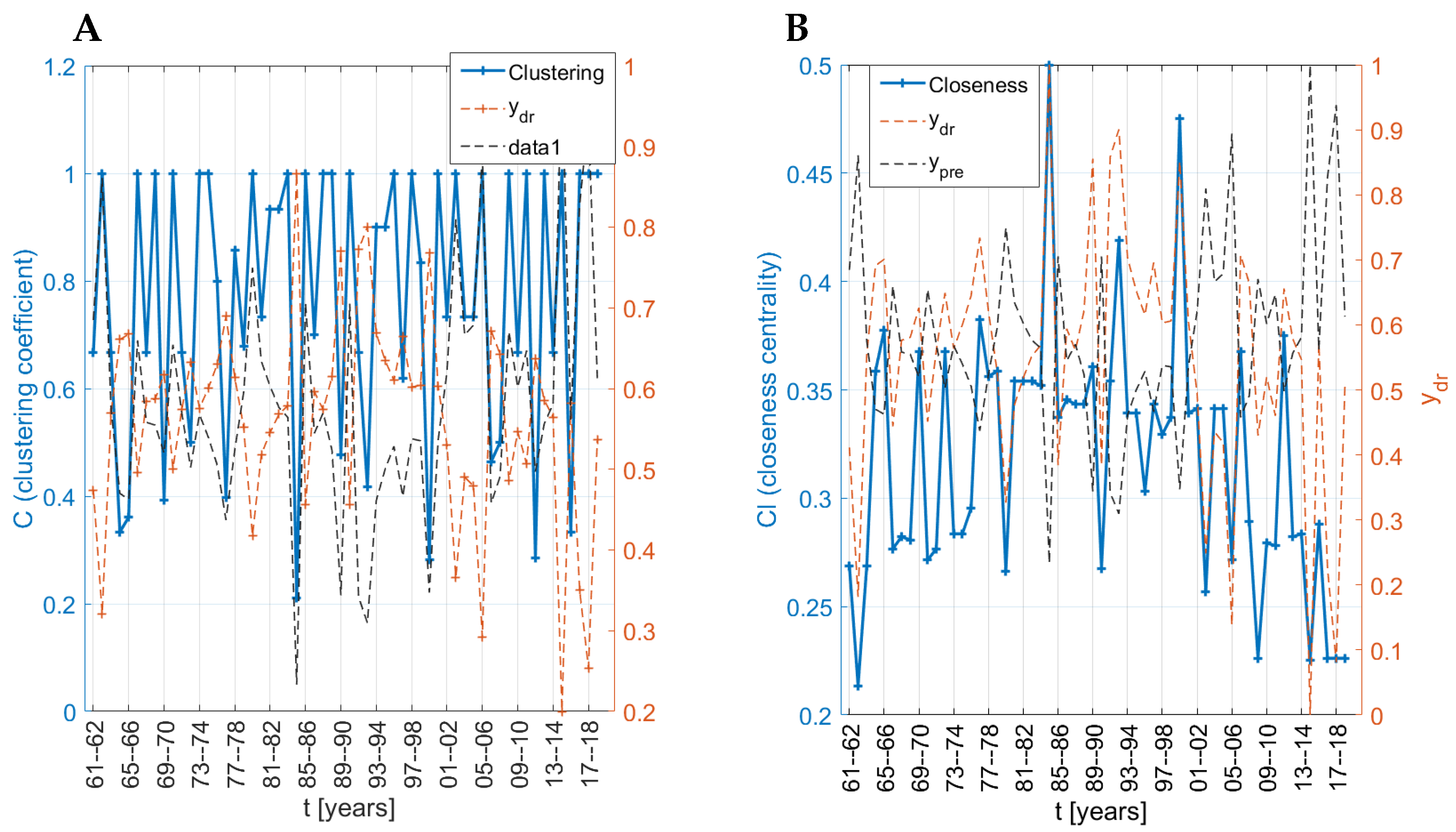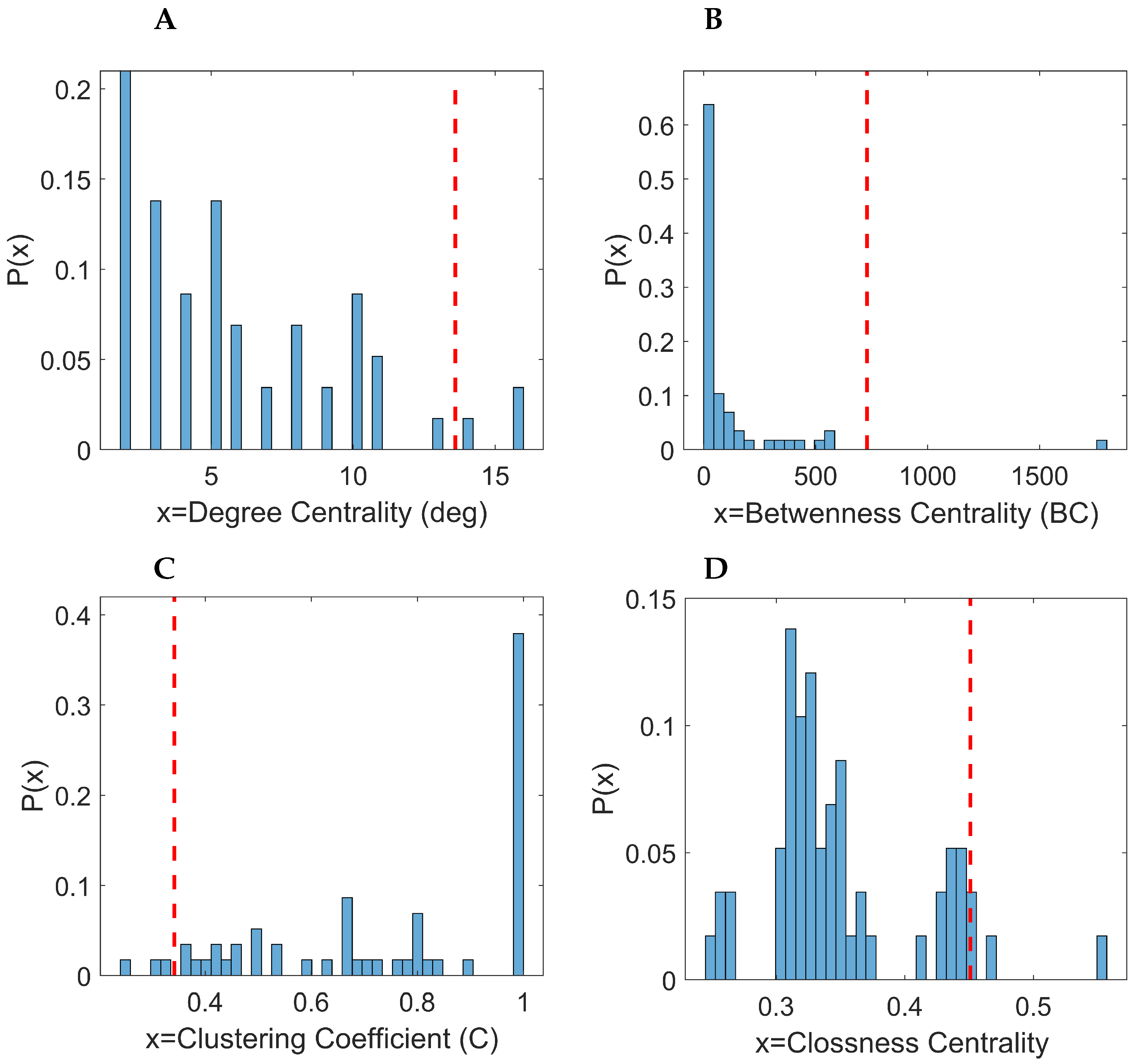Analysis of Annual Drought Episodes Using Complex Networks
Abstract
1. Introduction
2. Materials and Methods
2.1. Network Construction Using Visibility Algorithm
2.2. Measures Characterizing the Drought Network Connectivity
2.2.1. Degree Centrality
2.2.2. Path Lengths, Closeness Centrality and Clustering Coefficient
2.2.3. Betweenness Centrality
2.3. Detection of Communities and Modularity
2.4. Data and Drought Time Series Preprocess
3. Case Study
4. Results
4.1. Localized Important Network Nodes: The Case of Arnaia
4.2. Macroscopic Network Measures: The Case of Arnaia
4.3. The Case of Florina
4.4. Localized Important Network Nodes: The Case of Florina
4.5. Macroscopic Network Measure for the Florina Case
4.6. Community Detection (Modularity) and Cyclicity of Drought Time Series in the Cases of Arnaia and Florina
5. Discussion
5.1. Utilizing Network Measure Distributions to Characterize Drought Rare Events
5.2. Comparison with the Standardized Precipitation Index-SPI
5.3. Emergent Cyclicity or Periodicity from Network Analysis
6. Conclusions
Author Contributions
Funding
Institutional Review Board Statement
Informed Consent Statement
Data Availability Statement
Conflicts of Interest
References
- Nations, U. Drought Sustainability. Available online: https://sdgs.un.org/documents/e200929-ecn17200919-report-17th-ses-18614 (accessed on 1 September 2024).
- Mugume, S.N.; Diao, K.; Astaraie-Imani, M.; Fu, G.; Farmani, R.; Butler, D. Enhancing resilience in urban water systems for future cities. Water Supply 2015, 15, 1343–1352. [Google Scholar] [CrossRef][Green Version]
- Tsakiris, G.; Loucks, D. Adaptive Water Resources Management Under Climate Change: An Introduction. Water Resour Manag. 2019, 37, 2221–2233. [Google Scholar] [CrossRef]
- Tabari, H.; Willems, P. Sustainable development substantially reduces the risk of future drought impacts. Commun. Earth Environ. 2023, 4, 180. [Google Scholar] [CrossRef]
- Kourtis, I.M.; Vangelis, H.; Tigkas, D.; Mamara, A.; Nalbantis, I.; Tsakiris, G.; Tsihrintzis, V. Drought Assessment in Greece Using SPI and ERA5 Climate Reanalysis Data. Sustainability 2023, 15, 15999. [Google Scholar] [CrossRef]
- Boers, N.; Goswami, B.; Rheinwalt, A.; Bookhagen, B.; Hoskins, B.; Kurths, J. Complex networks reveal global pattern of extreme-rainfall teleconnections. Nature 2019, 566, 373–377. [Google Scholar] [CrossRef] [PubMed]
- Donges, J.F.; Zou, Y.; Marwan, N.; Kurths, J. Complex networks in climate dynamics. Eur. Phys. J. Spec. Top. 2009, 174, 157–179. [Google Scholar] [CrossRef]
- Mondal, S.; Mishra, A.K.; Leung, R.; Cook, B. Global droughts connected by linkages between drought hubs. Nat. Commun. 2023, 14, 144. [Google Scholar] [CrossRef]
- Lacasa, L.; Luque, B.; Ballesteros, F.; Luque, J.; Carlos Nuno, J. From time series to complex networks: The visibility graph. Proc. Natl. Acad. Sci. USA 2008, 105, 4972–4975. [Google Scholar] [CrossRef]
- Liu, C.; Zhou, W.; Yuan, W. Statistical properties of visibility graph of energy dissipation rates in three-dimensional fully developed turbulence. Phys. A Stat. Mech. Its Appl. 2010, 389, 2675–2681. [Google Scholar] [CrossRef]
- Charakopoulos, A.; Karakasidis, T.; Sarris, I. Analysis of magnetohydrodynamic channel flow through complex network analysis. Chaos Interdiscip. J. Nonlinear Sci. 2021, 31, 043123. [Google Scholar] [CrossRef] [PubMed]
- Telesca, L.; Lovallo, M. Analysis of seismic sequences by using the method of visibility graph. Europhys. Lett. 2012, 97, 50002. [Google Scholar] [CrossRef]
- Ahmadlou, M.; Adeli, H.; Adeli, A. Improved visibility graph fractality with application for the diagnosis of Autism Spectrum Disorder. Phys. A Stat. Mech. Its Appl. 2012, 391, 4720–4726. [Google Scholar] [CrossRef]
- Gao, Z.; Cai, Q.; Yang, Y.; Dong, N.; Zhang, S. Visibility Graph from Adaptive Optimal Kernel Time-Frequency Representation for Classification of Epileptiform EEG. Int. J. Neural Syst. 2017, 27, 1750005. [Google Scholar] [CrossRef]
- Zhuang, E.; Small, M.; Feng, G. Time series analysis of the developed financial markets’ integration using visibility graphs. Phys. A Stat. Mech. Its Appl. 2014, 410, 483–495. [Google Scholar] [CrossRef]
- Qian, M.C.; Jiang, Z.Q.; Zhou, W.X. Universal and nonuniversal allometric scaling behaviors in the visibility graphs of world stock market indices. J. Phys. A Math. Theor. 2010, 43, 335002. [Google Scholar] [CrossRef]
- John, R.; John, M. Adaptation of the visibility graph algorithm for detecting time lag between rainfall and water level fluctuations in Lake Okeechobee. Adv. Water Resour. 2019, 134, 103429. [Google Scholar] [CrossRef]
- Tsakiris, G.; Pangalou, D.; Vangelis, H. Regional Drought Assessment Based on the Reconnaissance Drought Index (RDI). Water Resour. Manag. 2007, 21, 821–833. [Google Scholar] [CrossRef]
- Nalbantis, I.; Tsakiris, G. Assessment of Hydrological Drought Revisited. Water Resour. Manag. 2009, 23, 881–897. [Google Scholar] [CrossRef]
- McKee, T.; Doesken, N.; Kleist, J. The Relationship of Drought Frequency and Duration to Time Scales. In Proceedings of the 8th Conference on Applied Climatology, Anaheim, CA, USA, 17–22 January 1993; pp. 179–184. [Google Scholar]
- Latifoğlu, L.; Özger, M. A Novel Approach for High-Performance Estimation of SPI Data in Drought Prediction. Sustainability 2023, 15, 14046. [Google Scholar] [CrossRef]
- Bullmore, E.; Sporns, O. Complex brain networks: Graph theoretical analysis of structural and functional systems. Nat. Rev. Neurosci. 2009, 10, 186–198. [Google Scholar] [CrossRef] [PubMed]
- Stam, C.J.; Reijneveld, J.C. Graph theoretical analysis of complex networks in the brain. Nonlinear Biomed. Phys. 2007, 1, 1753–4631. [Google Scholar] [CrossRef] [PubMed]
- Newman, M.E.J. Modularity and community structure in networks. Proc. Natl. Acad. Sci. USA 2006, 103, 8577–8582. [Google Scholar] [CrossRef]
- Daskalaki, E.; Papadopoulos, G.A.; Spiliotis, K.; Siettos, C. Analysing the topology of seismicity in the Hellenic arc using complex networks. J. Seismol. 2014, 18, 37–46. [Google Scholar] [CrossRef]
- Daskalaki, E.; Spiliotis, K.; Siettos, C.; Minadakis, G.; Papadopoulos, G.A. Foreshocks and short-term hazard assessment of large earthquakes using complex networks: The case of the 2009 L’Aquila earthquake. Nonlinear Process. Geophys. 2016, 23, 241–256. [Google Scholar] [CrossRef]
- Spiliotis, K.; Siettos, C. A timestepper-based approach for the coarse-grained analysis of microscopic neuronal simulators on networks: Bifurcation and rare-events micro- to macro-computations. Neurocomputing 2011, 74, 3576–3589. [Google Scholar] [CrossRef]
- Papana, A.; Kyrtsou, C.; Kugiumtzis, D.; Diks, C. Financial networks based on Granger causality: A case study. Phys. A Stat. Mech. Its Appl. 2017, 482, 65–73. [Google Scholar] [CrossRef]
- Chorozoglou, D.; Papadimitriou, E.; Kugiumtzis, D. Investigating small-world and scale-free structure of earthquake networks in Greece. Chaos Solitons Fractals 2019, 122, 143–152. [Google Scholar] [CrossRef]
- Watts, D.; Strogatz, S. Collective dynamics of ‘small-world’ networks. Nature 1998, 393, 440–442. [Google Scholar] [CrossRef]
- Wikipedia. Six Degrees of Kevin Bacon. Available online: https://en.wikipedia.org/wiki/Six_Degrees_of_Kevin_Bacon (accessed on 29 October 2022).
- Betzel, R.F.; Medaglia, J.D.; Papadopoulos, L.; Baum, G.L.; Gur, R.; Gur, R.; Roalf, D.; Satterthwaite, T.D.; Bassett, D.S. The modular organization of human anatomical brain networks: Accounting for the cost of wiring. Netw. Neurosci. 2017, 1, 42–68. [Google Scholar] [CrossRef] [PubMed]
- Marcoux, M.; Lusseau, D. Network modularity promotes cooperation. J. Theor. Biol. 2013, 324, 103–108. [Google Scholar] [CrossRef]
- Barabási, A.L.; Pósfai, M. Network Science; Cambridge University Press: Cambridge, UK, 2016. [Google Scholar]
- Newman, M. Networks, An Introductions; Oxford University Press: New York, NY, USA, 2010. [Google Scholar]
- Leicht, E.A.; Newman, M.E.J. Community Structure in Directed Networks. Phys. Rev. Lett. 2008, 100, 118703. [Google Scholar] [CrossRef] [PubMed]
- Karavitis, C.; Alexandris, S.; Tsesmelis, D.E.; Athanasopoulos, G. Application of the Standardized Precipitation Index (SPI) in Greece. Water 2011, 3, 787–805. [Google Scholar] [CrossRef]
- Tigkas, D. Drought Characterisation and Monitoring in Regions of Greece. Eur. Water EWRA 2008, 23/24, 29–39. [Google Scholar]
- Yevjevich, V. An Objective Approach to Definitions and Investigations of Continental Hydrologic Droughts; Hydrology Papers No. 23; Colorado State University: Fort Collins, CO, USA, 1967. [Google Scholar]
- Burka, A.; Biazin, B.; Bewket, W. Drought characterization using different indices, theory of run and trend analysis in bilate river watershed, rift valley of Ethiopia. Front. Environ. Sci. 2023, 11, 1098113. [Google Scholar] [CrossRef]
- Huang, S.; Chang, J.; Huang, Q.; Chen, Y. Spatio-temporal Changes and Frequency Analysis of Drought in the Wei River Basin, China. Water Resour. Manag. 2014, 28, 3095–3110. [Google Scholar] [CrossRef]
- Merino, A.; López, L.; Hermida, L.; Sánchez, J.; García-Ortega, E.; Gascón, E.; Fernández-González, S. Identification of drought phases in a 110-year record from Western Mediterranean basin: Trends, anomalies and periodicity analysis for Iberian Peninsula. Glob. Planet. Change 2015, 133, 96–108. [Google Scholar] [CrossRef]
- Moreira, E.E.; Martins, D.S.; Pereira, L.S. Assessing drought cycles in SPI time series using a Fourier analysis. Nat. Hazards Earth Syst. Sci. 2015, 15, 571–585. [Google Scholar] [CrossRef]











Disclaimer/Publisher’s Note: The statements, opinions and data contained in all publications are solely those of the individual author(s) and contributor(s) and not of MDPI and/or the editor(s). MDPI and/or the editor(s) disclaim responsibility for any injury to people or property resulting from any ideas, methods, instructions or products referred to in the content. |
© 2025 by the authors. Licensee MDPI, Basel, Switzerland. This article is an open access article distributed under the terms and conditions of the Creative Commons Attribution (CC BY) license (https://creativecommons.org/licenses/by/4.0/).
Share and Cite
Spiliotis, K.; Voudouris, K.; Vangelis, H.; Spiliotis, M. Analysis of Annual Drought Episodes Using Complex Networks. Sustainability 2025, 17, 1441. https://doi.org/10.3390/su17041441
Spiliotis K, Voudouris K, Vangelis H, Spiliotis M. Analysis of Annual Drought Episodes Using Complex Networks. Sustainability. 2025; 17(4):1441. https://doi.org/10.3390/su17041441
Chicago/Turabian StyleSpiliotis, Konstantinos, Konstantinos Voudouris, Harris Vangelis, and Mike Spiliotis. 2025. "Analysis of Annual Drought Episodes Using Complex Networks" Sustainability 17, no. 4: 1441. https://doi.org/10.3390/su17041441
APA StyleSpiliotis, K., Voudouris, K., Vangelis, H., & Spiliotis, M. (2025). Analysis of Annual Drought Episodes Using Complex Networks. Sustainability, 17(4), 1441. https://doi.org/10.3390/su17041441




_S._Voudouris.png)



